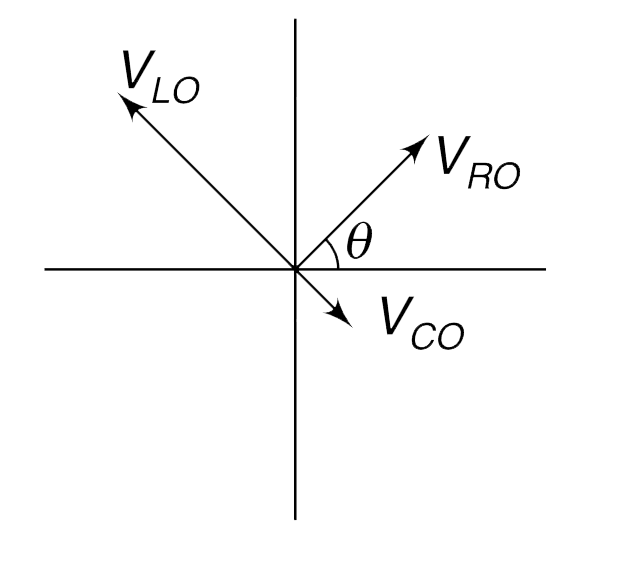An LCR series circuit behaves like a damped harmonic oscillator. Comparing it with a physical spring-mass damped oscillator having damping constant ‘b’, the correct equivalence would be (Take, i = current, V = voltage, x = displacement, q = charge, F = force, v = velocity)
q↔x,v<↔>i,F↔V
q↔v,i↔x,F↔V
q↔x,v↔V,F→i
q↔F,i↔x,V→v
The correct Answer is:A

For physical spring mass damped oscillator:
ma+bv+kx=0
⇒md2xdt2+tdxdt+kx=0
For LCR series circuit:
−iR−Ldidt−qc=0
⇒Ld2dt+Rdqdt+qc=0 . . . (ii)
Comparing eqn (i) & (ii)
x↔dxdt,qc↔kxor,x↔q,i↔v,V↔F.
Similar Questions
A ball of mass m when suspended by a spring stretches the latter by Δl. Due to external vertical lforce varying according to a harmonic law with amplitude F0 the ball performs forced oscillations. The logarighmic damping decrement if equal to λ. Neglecting the mass the spring, find the angular frequency of the external force at which the displacemetn amplitude of the ball is maximum. What is the magnitude of that amplitude ?
View SolutionA point performs damped oscillations with frequency ω and damping coefficient β according to the (4.1b). Find the initial amplitude a0 and the initial phase α if at the moment t=0 the displacement of the point and its velocity projection are equal to
(a) x(0)=0 and ux(0)=.x0 ,
(b) x(0)=x0 and vx(0)=0.View Solution
Knowledge Check
- Question 1 - Select One
An LCR circuit behaves like a damped harmonic oscillator. Comparing it with a physical spring mass damped oscillator having damping constant b, the correct equivalence of b would be:
Ab↔RBb↔cCb↔1RDb↔1L - Question 2 - Select One
A LCR circuit behaves like a damped harmonic oscillator. Comparing it with a physical spring mass damped oscillator having damping constant ‘b’. If the amount of initial charge on the capacitor be Q0. then the amplitude of the amount of charge on the capacitor as a function of time t will be:
AQ=Q0e−Rt2IBQ=Q0(1−e2RtL)CQ=Q0e−RtLDQ=Q0(1−e−RtL) - Question 3 - Select One
A LCR circuit be haves like a damped harmonic oscillator. The discharge of capacitor C, through an C□ inductor L having resistance R is oscillatory. Then which of following is correct _____.
A1LC<R24L2B1LC>R24L2C1LC>R34L4D1√LC>R38
In a series LCR circuit the phasors corresponding to voltage across resistance, capacitor and inductor at an instant are as shown in the Figure and have amplitudes ofVRO=4volt,VCO=3volt,andVLO=6volt
(a) Is the source frequency larger than or lesser than the resonance frequency? Does the current (I) lead or lag the source voltage?
(b) Find the voltage amplitude of the source.
(c) If VR phasor makes θ=53∘ at time t = 0, write the source voltage as function of time. Take angular frequency of the source to be ω[sin53∘=45]
 View Solution
View SolutionAn LCR series circuit is connected to an oscillator (AC supply) having RMS voltage 200 V. If the RMS voltages across resistor, inductor and capacitor are equal, then RMS voltage across the resistor would be
View SolutionThere is a LCR circuit , If it is compared with a damped oscillation of mass m oscillating with force constant k and damping coefficient 'b'. Compare the terms of damped oscillation with the devices in LCR circuit.
View SolutionL-C oscillation is not realistic for the following reasons.
Every inductor has some resistance.
The effect of resistance is to introduce a damping effect on the charge and current in the circuit and the oscillations finally die away.
Even. if the resistance is zero, the total energy of the system would not remain constant .It is radiated away from the system in the form of electromagnetic waves.
Which of the above reasons are correct?View SolutionA physics lab is designed to study the transfer of electrial energy from one circuit to another by means of a magnetic field using simple transformers. Each transformer has two coils of wire electrically insulated from each other but wound a round a common core of ferromagnetic material. The two wires are close together but do not touch each other
The primary (1∘) coil is connected to a source of alternating (AC) current. The secondary (2∘) coil is connected to resistor such as a light bulb. The AC source produces on oscillating voltage and current in the primary coil that produces an oscillating megnetic field in the core. material. This in turn induces an oscillating voltage and AC curent in the secondary coil
Students collected the following data comparing the number of turns per coil (N), the voltage (V) and the current (I) in the coils of three transformers.
∣∣ ∣ ∣ ∣∣Transformerprimary coilSecondary coil1100.10V.10A200.20V.5A2100.10V.10A50.5V.5A3100.10V.10A100.5V.20A∣∣ ∣ ∣ ∣∣

A 12V battery is used to supply 2.0mA of current to the 300 turns in the primary coil of a given transformer. What is the current in the secondary coil if N2=150 turns.View Solution

